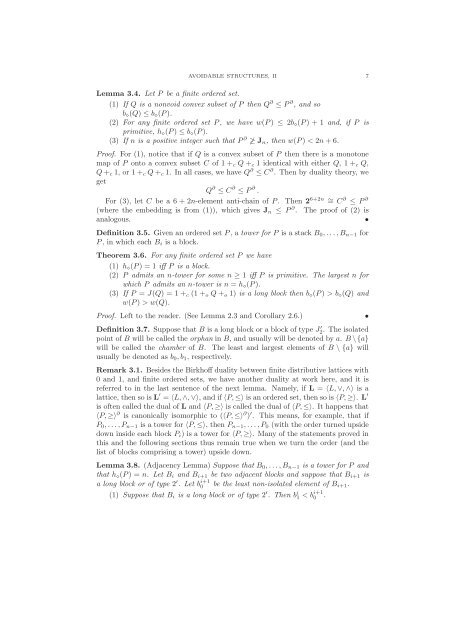Avoidable structures, II: finite distributive lattices and nicely ...
Avoidable structures, II: finite distributive lattices and nicely ...
Avoidable structures, II: finite distributive lattices and nicely ...
Create successful ePaper yourself
Turn your PDF publications into a flip-book with our unique Google optimized e-Paper software.
AVOIDABLE STRUCTURES, <strong>II</strong> 7<br />
Lemma 3.4. Let P be a <strong>finite</strong> ordered set.<br />
(1) If Q is a nonvoid convex subset of P then Q ∂ ≤ P ∂ , <strong>and</strong> so<br />
b ⋄ (Q) ≤ b ⋄ (P).<br />
(2) For any <strong>finite</strong> ordered set P, we have w(P) ≤ 2b ⋄ (P) + 1 <strong>and</strong>, if P is<br />
primitive, h ⋄ (P) ≤ b ⋄ (P).<br />
(3) If n is a positive integer such that P ∂ ≱ J n , then w(P) < 2n+6.<br />
Proof. For (1), notice that if Q is a convex subset of P then there is a monotone<br />
map of P onto a convex subset C of 1+ c Q+ c 1 identical with either Q, 1+ c Q,<br />
Q+ c 1, or 1+ c Q+ c 1. In all cases, we have Q ∂ ≤ C ∂ . Then by duality theory, we<br />
get<br />
Q ∂ ≤ C ∂ ≤ P ∂ .<br />
For (3), let C be a 6 + 2n-element anti-chain of P. Then 2 6+2n ∼ = C ∂ ≤ P ∂<br />
(where the embedding is from (1)), which gives J n ≤ P ∂ . The proof of (2) is<br />
analogous.<br />
•<br />
Definition 3.5. Given an ordered set P, a tower for P is a stack B 0 ,...,B n−1 for<br />
P, in which each B i is a block.<br />
Theorem 3.6. For any <strong>finite</strong> ordered set P we have<br />
(1) h ⋄ (P) = 1 iff P is a block.<br />
(2) P admits an n-tower for some n ≥ 1 iff P is primitive. The largest n for<br />
which P admits an n-tower is n = h ⋄ (P).<br />
(3) If P = J(Q) = 1+ c (1+ o Q+ o 1) is a long block then b ⋄ (P) > b ⋄ (Q) <strong>and</strong><br />
w(P) > w(Q).<br />
Proof. Left to the reader. (See Lemma 2.3 <strong>and</strong> Corollary 2.6.)<br />
Definition 3.7. Suppose that B is a long block or a block of type J ′ 2. The isolated<br />
point of B will be called the orphan in B, <strong>and</strong> usually will be denoted by a. B\{a}<br />
will be called the chamber of B. The least <strong>and</strong> largest elements of B \ {a} will<br />
usually be denoted as b 0 ,b 1 , respectively.<br />
Remark 3.1. Besides the Birkhoff duality between <strong>finite</strong> <strong>distributive</strong> <strong>lattices</strong> with<br />
0 <strong>and</strong> 1, <strong>and</strong> <strong>finite</strong> ordered sets, we have another duality at work here, <strong>and</strong> it is<br />
referred to in the last sentence of the next lemma. Namely, if L = 〈L,∨,∧〉 is a<br />
lattice, then so is L ′ = 〈L,∧,∨〉, <strong>and</strong> if 〈P,≤〉 is an ordered set, then so is 〈P,≥〉. L ′<br />
is often called the dual of L <strong>and</strong> 〈P,≥〉 is called the dual of 〈P,≤〉. It happens that<br />
〈P,≥〉 ∂ is canonically isomorphic to (〈P,≤〉 ∂ ) ′ . This means, for example, that if<br />
P 0 ,...,P n−1 is a tower for 〈P,≤〉, then P n−1 ,...,P 0 (with the order turned upside<br />
down inside each block P i ) is a tower for 〈P,≥〉. Many of the statements proved in<br />
this <strong>and</strong> the following sections thus remain true when we turn the order (<strong>and</strong> the<br />
list of blocks comprising a tower) upside down.<br />
Lemma 3.8. (Adjacency Lemma) Suppose that B 0 ,...,B n−1 is a tower for P <strong>and</strong><br />
that h ⋄ (P) = n. Let B i <strong>and</strong> B i+1 be two adjacent blocks <strong>and</strong> suppose that B i+1 is<br />
a long block or of type 2 ′ . Let b i+1<br />
0 be the least non-isolated element of B i+1 .<br />
(1) Suppose that B i is a long block or of type 2 ′ . Then b i 1 < b i+1<br />
0 .<br />
•
















